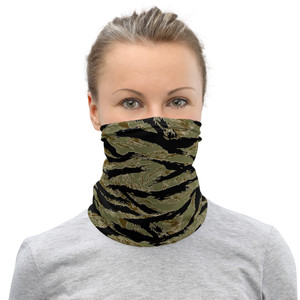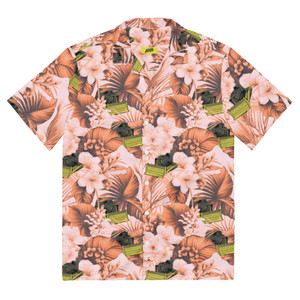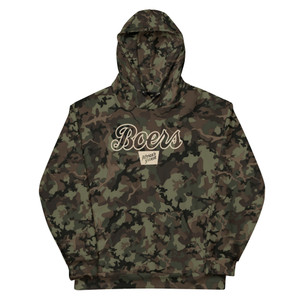
Tiger stripe is the name of a group of camouflage patterns developed for close-range use in dense jungle during jungle warfare by the South Vietnamese Armed Forces and adopted in late 1962 to early 1963 by US Special Forces during the Vietnam War. During and after the Vietnam War, the pattern was adopted by several other Asian countries. It derives its name from its resemblance to a tiger's stripes. It features narrow stripes that look like brush-strokes of green and brown, and broader brush-strokes of black printed over a lighter shade of olive or khaki. The brush-strokes interlock rather than overlap, as in French Lizard pattern (TAP47) from which it apparently derives.
It is unclear who developed the first tiger stripe pattern, consisting of 64 stripes. The French used a similar pattern called "lizard" in the First Indochina War. After the French left Vietnam, the Republic of Vietnam Marine Division began using a derived pattern which differed in having interlocking elements instead of overlapping ones. Variants of the pattern were later adopted by Vietnamese Rangers (Biệt Động Quân) and Special Forces (Lực Lượng Đặc Biệt). When the United States began sending advisors to South Vietnam, USMAAG advisors attached to the ARVN were authorized to wear their Vietnamese unit's combat uniform with US insignia. Soon, many American special operations forces in the Vietnamese theater of operations wore the pattern, despite not always being attached to ARVN units.
Tiger stripe was never an official US-issue item. Personnel permitted to wear it at first had their camo fatigues custom-made by local tailors, with ARVN uniforms being too small for most Americans; for this reason there were many variations of the basic tiger stripe pattern. In 1963, Marine Corps Advisors and from 1964, 5th Special Forces Group of the Green Berets contracted with Vietnamese and other Southeast Asian producers to make fatigues and other items such as boonie hats using tiger stripe fabric. Being manufactured by different producers in places like Thailand, Korea and Okinawa, Japan, there was a wide variety of patterns and color shade variations. They were made in both Asian and US sizes.
During the latter stages of the war, tiger stripe was gradually replaced in American reconnaissance units by the then-new ERDL pattern, a predecessor of the US four-color woodland pattern. The Special Forces-advised Civilian Irregular Defense Group (CIDG) used tiger stripe from 1963 until disbanded in 1971. Special Forces personnel wore tiger stripe when conducting operations with the CIDG.
Besides American and ARVN forces, Australian and New Zealand military personnel used tiger stripe uniforms while on advisory duty with the ARVN units. Personnel from the Australian Special Air Service Regiment and the New Zealand Special Air Service were the principal wearers of tiger-stripe uniforms (and ERDL uniforms) in theater, while regular Australian and New Zealand troops wore the standard-issue olive green uniforms.
Thailand and the Philippines have been the most prolific manufacturers of tiger stripe designs since the Vietnam War. Philippine Naval Special Operations Command personnel wear tiger stripe combat uniforms.
The pattern was tested by the USMC prior to the adoption of MARPAT through the Scout Sniper Instructor School.
Meet your new favorite summer shirt! It exudes coolness both in terms of style and material. Plus, its featherlight and moisture-wicking material ensures comfort even on the hottest days.
• 65% recycled polyester, 35% polyester
• Fabric weight: 2.95 oz/yd² (100 g/m²)
• Breathable and moisture-wicking material
• Oversized fit
• UPF50+ protection
• Blank product components sourced from China
Disclaimers:
• In areas where the fabric is double-layered, details from the inner fabric layer may subtly show through, especially with lighter designs.
• After washing, the fabric will become softer.
This product is made especially for you as soon as you place an order, which is why it takes us a bit longer to deliver it to you. Making products on demand instead of in bulk helps reduce overproduction, so thank you for making thoughtful purchasing decisions!
It is unclear who developed the first tiger stripe pattern, consisting of 64 stripes. The French used a similar pattern called "lizard" in the First Indochina War. After the French left Vietnam, the Republic of Vietnam Marine Division began using a derived pattern which differed in having interlocking elements instead of overlapping ones. Variants of the pattern were later adopted by Vietnamese Rangers (Biệt Động Quân) and Special Forces (Lực Lượng Đặc Biệt). When the United States began sending advisors to South Vietnam, USMAAG advisors attached to the ARVN were authorized to wear their Vietnamese unit's combat uniform with US insignia. Soon, many American special operations forces in the Vietnamese theater of operations wore the pattern, despite not always being attached to ARVN units.
Tiger stripe was never an official US-issue item. Personnel permitted to wear it at first had their camo fatigues custom-made by local tailors, with ARVN uniforms being too small for most Americans; for this reason there were many variations of the basic tiger stripe pattern. In 1963, Marine Corps Advisors and from 1964, 5th Special Forces Group of the Green Berets contracted with Vietnamese and other Southeast Asian producers to make fatigues and other items such as boonie hats using tiger stripe fabric. Being manufactured by different producers in places like Thailand, Korea and Okinawa, Japan, there was a wide variety of patterns and color shade variations. They were made in both Asian and US sizes.
During the latter stages of the war, tiger stripe was gradually replaced in American reconnaissance units by the then-new ERDL pattern, a predecessor of the US four-color woodland pattern. The Special Forces-advised Civilian Irregular Defense Group (CIDG) used tiger stripe from 1963 until disbanded in 1971. Special Forces personnel wore tiger stripe when conducting operations with the CIDG.
Besides American and ARVN forces, Australian and New Zealand military personnel used tiger stripe uniforms while on advisory duty with the ARVN units. Personnel from the Australian Special Air Service Regiment and the New Zealand Special Air Service were the principal wearers of tiger-stripe uniforms (and ERDL uniforms) in theater, while regular Australian and New Zealand troops wore the standard-issue olive green uniforms.
Thailand and the Philippines have been the most prolific manufacturers of tiger stripe designs since the Vietnam War. Philippine Naval Special Operations Command personnel wear tiger stripe combat uniforms.
The pattern was tested by the USMC prior to the adoption of MARPAT through the Scout Sniper Instructor School.
Meet your new favorite summer shirt! It exudes coolness both in terms of style and material. Plus, its featherlight and moisture-wicking material ensures comfort even on the hottest days.
• 65% recycled polyester, 35% polyester
• Fabric weight: 2.95 oz/yd² (100 g/m²)
• Breathable and moisture-wicking material
• Oversized fit
• UPF50+ protection
• Blank product components sourced from China
Disclaimers:
• In areas where the fabric is double-layered, details from the inner fabric layer may subtly show through, especially with lighter designs.
• After washing, the fabric will become softer.
This product is made especially for you as soon as you place an order, which is why it takes us a bit longer to deliver it to you. Making products on demand instead of in bulk helps reduce overproduction, so thank you for making thoughtful purchasing decisions!
Size guide
| CHEST (inches) | WAIST (inches) | HIPS (inches) | |
| 2XS | 34 ⅝ | 28 ¼ | 35 ⅜ |
| XS | 36 ¼ | 29 ⅞ | 37.0 |
| S | 37 ¾ | 31 ½ | 38 ⅝ |
| M | 39 ⅜ | 33 ⅛ | 40 ¼ |
| L | 42 ½ | 36 ¼ | 43 ¼ |
| XL | 45 ¾ | 39 ⅜ | 46 ½ |
| 2XL | 48 ¾ | 42 ½ | 49 ⅝ |
| 3XL | 52.0 | 45 ¾ | 52 ¾ |
| 4XL | 55 ⅛ | 48 ¾ | 55 ⅞ |
| 5XL | 58 ¼ | 52.0 | 59 ⅛ |
| 6XL | 61 ⅜ | 55 ⅛ | 62 ¼ |












